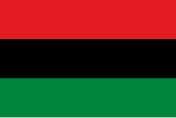This is an old revision of this page, as edited by Petri Krohn (talk | contribs) at 02:34, 26 February 2006 (→External links: fixed link). The present address (URL) is a permanent link to this revision, which may differ significantly from the current revision.
Revision as of 02:34, 26 February 2006 by Petri Krohn (talk | contribs) (→External links: fixed link)(diff) ← Previous revision | Latest revision (diff) | Newer revision → (diff)| The neutrality of this article is disputed. Relevant discussion may be found on the talk page. Please do not remove this message until conditions to do so are met. (Learn how and when to remove this message) |

The red, black and green flag was created by the members of the Universal Negro Improvement Association and African Communities League at their convention held in Madison Square Garden on August 13, 1920.
The three colors represent:
- red: the noble blood that unites all people of African ancestry;
- black: black people whose dignity is upheld by the existence of the flag; and
- green: the abundant natural wealth of the Motherland, Africa.
The flag was created by the members of the UNIA in response to a racist song written in 1900 entitled "The Only Race without a Flag is the Coon"; the song was written by Will A. Heelan and J. Fred Helf and popular in the U.S. and Britain.
The flag later became a black nationalist symbol for the liberation African people everywhere. Its colors can be seen in the flags of a number of African nations.
"The RED, BLACK and GREEN Flag was unveiled to the world by the Honorable Marcus Mosiah Garvey and the members of the Universal Negro Improvement Association and African Communities League, of the World at its first international convention on August 13, 1920. The UNIA-ACL knew that Africans at home and abroad needed their own flag as other flags around the world could not represent the collective of African people.
The use of Red, Black and Green as colors symbolizing African nationhood was first "adopted by the UNIA-ACL as part of the 1920 Declaration of Rights as the official colors of the African race. The question of a flag for the race was not as trivial as might have appeared on the surface, for in the United States especially, the lack of an African symbol of nationhood seems to have been cause for crude derision on the part of whites and a source of sensitivity on the part of Afro-Americans. White derision over this deficiency was summed up in a popular American song, "Every Race Has a Flag But the 'Coon.'" A 1912 report appearing in the Africa Times and Orient Review (for which Marcus Garvey worked) documented the far-reaching consequences of this song. In 1921 he declared,
"Show me the race or the nation without a flag, and I will show you a race of people without any pride. Aye! In song and mimicry they have said, "Every race has a flag but the coon." How true! Aye! But that was said of us four years ago. They can't say it now...." -Marcus Garvey
The race catechism Garveyites used explained the significance of the red, black, and green as for the "color of the blood which men must shed for their redemption and liberty", black for "the color of the noble and distinguished race to which we belong," and green for "the luxuriant vegetation of our Motherland."3
A flag must represent the standard by which its people live. Thus, the Universal African Flag, the 52nd Article of the Declaration of Rights of the Negro Peoples of the World was ratified in convention.
There has been a great deal of talk and controversy over the origin, creation and use of the Red, Black and Green. The UNIA hopes that this controversy can be clarified once and for all.
There was no Red, Black and Green Flag prior to the coming of the Honorable Marcus Garvey and the founding of the UNIA. Today there are many African Nations that have adopted the colors Red, Black and Green after the great Marcus Garvey and his program of African Redemption. Any one claiming the creation of the Red, Black and Green is historically incorrect. The UNIA organization will make every attempt to clear up any misunderstandings about the matter concerning the Red, Black and Green. Further confusion can be misleading to the masses of Blacks throughout the country and the world.
The following paragraph is the official historical creation and usage of the Red, Black and Green:
- Notice to the General Public: The UNIA in 1920 in international convention adopted the Red, Black and Green as its official colors and emblem of the Black people of the world. This flag has been flown upside down contrary to the intention of Marcus Garvey and the UNIA who gave it to the world. It is unlawful, disrespectful and traitorous for any individual or group to add any other colors to the Red, Black and Green for any other purpose. Individuals or groups doing so are not true nationalist, and should not be recognized as such.
External links
- The UNIA-ACL official website
- "Every Race Has a Flag But the 'Coon.":
- Sheet music from a Johns Hopkins University website
- Sheet music from the American Memory website of the Library of Congress